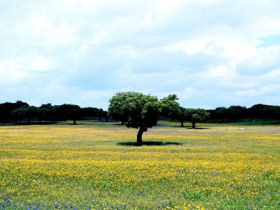Ordiel Marshes


Images of Marismas del Ordiel : CMA de la Junta de Andalucía
Information from Ramsar Directory of Wetlands of International Importance
Regions of SpainImportance: The area is extremely important for waterbirds. A colony of Platalea leucorodia (>400 pairs) occurs on Isla de Enmedio (one of only two Spanish nesting sites for this species, the other site being Doñana). Other breeding species include Ardea cinerea (>300 pairs), A. purpurea (>300 pairs), Egretta garzetta , Circus aeruginosus , Porphyrio porphyrio , Himantopus himantopus , Glareola pratincola , Charadrius alexandrinus , Larus genei , Gelochelidon nilotica and Sterna albifrons (>300 pairs). Large numbers of shorebirds stage in the area during migration periods, while wintering birds include Anas penelope , A. platyrhynchos , A. clypeata , Aythya ferina and Recurvirostra avosetta .
Wetland Types: 5 , Tp , Sp , H , E (dominant types shown in bold)
The site is an extensive complex of marshes at the mouth of the River Odiel, in the vicinity of its confluence with the River Tinto, with sandy dunes, intertidal marshes, permanent saline and brackish pools, permanent freshwater lakes, and artificial salt pans. Saltmarshes constitute the most important wetland type.
Biological/Ecological notes: Several distinctive habitats can be identified. The lower saltmarsh is frequently inundated at high tides, and characterised by the presence of Spartina maritima and Salicornia ramosissima . The middle saltmarsh, less frequently inundated, has a vegetation characterised by Sarcocornia perennis and Halimione portulacoides . On the upper saltmarsh, well consolidated and infrequently inundated, the vegetation is composed of Spartina densiflora , Arthrocnemum macrostachyum , Inula crithmoides and Artemisia sp. The inland marshes are influenced by freshwater and support beds of Phragmites australis , Typha latifolia and Juncus spp. There also are sand dune spits, characterised by Pinus pinea and Juniperus phoenicia .
Hydrological/Physical notes: Most of the site is flat, intertidal marsh.
Human Uses: Land use within the site includes salt extraction (about 1,000 ha of the marshes have been converted to salt pans), forestry, agriculture, fishing and shellfish harvesting.
Information adapted from UNESCO Biosphere Reserve Directory
The Marismas del Odiel Biosphere Reserve is located in the north-west of Cadiz in the Province of Huelva, at the mouth of the Odiel River. It is also a Ramsar site and a Special zone for birds protection in the European Union. This coastal area includes extensive marshlands and the island of Enmedio surrounded by the villages of Huelva, Gibraleon, Aljaraque and Punta Umbría. It comprises evergreen sclerophyllous forests, woodlands and scrub, including tidal marshes, beaches and dunes, wetland and salt works. A number of studies have been conducted on the marshland ecosystems and its bird species (more than 200 species are reported). The area is also of archeological interest. Access to the marshlands of Odiel is easy due to an extensive marine and terrestrial communication network. Only 10 people live in the biosphere reserve (2001). Human activities consist mainly of salt extraction in the northern part of the reserve. Not more than 100 heads of cattle are still allowed to graze. On the Saltes islands, controlled sport and commercial fishing is taking place.
Major habitats & land cover types Tidal marshes; beaches and dunes; forests; wetland; salt works
- Albufera de Adra
- Bahia de Cadiz
- Cabo de Gata-Nijar
- Climate of Andalusia
- Doñana
- Flora and wildlife of Andalusia
- Geography of Andalusia
- Grazalema
- History of Andalucia
- Laguna de Fuente de Piedra
- Las Dehesas de Sierra Morena
- Las Sierras de Cazorla y Segura
- Los Alcornocales
- Nature reserves in Andalusia
- Ordiel Marshes
- Sierra Nevada
- Aiguamolls de l’Empordà Natural Park
- Aigüestortes i Estany de Sant Maurici
- Birding sites in Catalonia
- Cap de Creus
- Catalonia earthquake of 1428
- Congost de Mont-rebei / Mont-rebei gorge
- Delta del Ebro
- Els Ports
- Garraf
- Lake Banyoles
- Lerida Steppes
- Montseny
- Pica d’Estats
- Sant Llorenç del Munt
- Serra de Montsec
- Sierra de Cadi
The Iberianature guide to Spain


 Andalusia with its rugged mountains and stunning scenery offers some of the best hiking in Europe.
Andalusia with its rugged mountains and stunning scenery offers some of the best hiking in Europe.